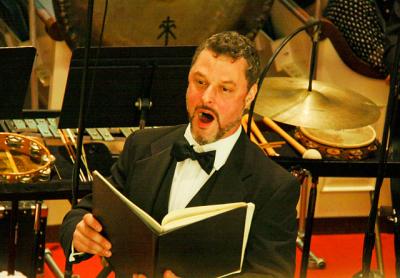The Choral Society's Passionate Music Making

The Choral Society of the Hamptons closed its 2017-2018 concert season on Saturday at the Bridgehampton Presbyterian Church with two performances of Carl Orff’s “Carmina Burana,” one of the most popular and widely performed pieces in the choral repertoire. A large and expectant audience attended the 5 p.m. performance, which I attended.
“Carmina Burana” was written in 1937 for chorus, large orchestra, two pianos, boys choir, and a great deal of percussion, and it was intended for performance with dance and visual elements. Its immediate popularity resulted in a reduced version for two pianos and percussion, allowing for performances by choirs with more modest resources, and that version was offered on Sunday.
Much of this variation and contrast in the work is provided by Orff’s use of orchestral color and by sudden juxtaposition of varying masses of choral and orchestral sound. Orchestral color is not available in this arrangement (approved by Orff) but rhythmic energy and dynamic contrast remain intact and opportunities abound for passionate and compelling music making.
The Choral Society singers, three soloists, and a children’s chorus, as well as the pianists and percussion ensemble, under the direction of the society’s music director, Mark Mangini, made the most of them.
These opportunities lie in the text and Orff’s masterful setting of 24 medieval poems bewailing the fickleness of fortune and extolling the pleasures of love, lust, drinking, and other pursuits of young students in the 11th hrough 13th centuries. (In “Catulli Burana,” part of the triptych to which “Carmina” belongs, cautious community choruses have occasionally chosen to omit translations of some of the racier portions of these texts.)
The opening movement, “O Fortuna,” may be the most widely familiar choral music in the repertoire, having been used in movies, commercials, television shows, video games, and figure-skating routines. The piece literally begins with a bang, the tympanist nearly punching a hole in the skin of his drum and the singers entering a beat later with a full-voiced howl at the cruel and inevitable mistreatments dealt by fortune.
The effect of this opening is enhanced by an immediate contrast with a soft but intense elaboration of fortune’s misdeeds, the intensity largely achieved by precise and emphatic articulation of consonants. Mr. Mangini’s careful preparation of the singers was immediately evident here, as it was in the handling of the many changes in meter and tempo that Orff frequently calls for and in the accelerando in “Tempus est Iocundum.”
The chorus was joined by three soloists, all of whom acquitted themselves wonderfully, if very differently. The soprano Chelsea Shephard’s rendering of one of the most song-like numbers was a pleasure, the tenor Alex Guerrero sang the famously high solo of the roasted swan in a wonderful and pure non-falsetto, and the baritone Dominic Inferrera dazzled with range and expressivity.
The full ensemble was joined twice by the well-prepared young singers from Sag Harbor’s Pierson School, and the contrast with the mature voices of the soloists and Choral Society singers was delightful. Their presence had the added benefit of bringing parents, grandparents, and siblings to a performance they may not have attended otherwise. One has to wonder, though, what the families of these talented youngsters, primarily girls, may have thought about the decision to substitute them for the boys choir that sings about virginity making them “frisky.”
The intensity, passion, and confidence of the chorus seemed to increase as it approached the closing numbers so that as fortune’s wheel completed its turn with the reprise of “O Fortuna,” the tricky dissonances of the opening measures were sung with more conviction and more bite than they had been at the opening. The opening may have been more effective in the second performance. The reprise, however, made for an exciting and satisfying close to the concert.
Despite the preparation and passion of the singers, the skill and precision of the pianists, Konstantin Soukhovetski and Matthew Maimone, and the power provided by the five percussionists, the absence of full orchestral accompaniment was frequently felt and occasionally almost fatal. This was especially true in some of the slower movements. The orchestra is often called upon to provide lengthy sustained chords underneath the singers, something a piano is simply unable to do. If it is a matter of resources, the Choral Society deserves the kind of support that would allow it to provide community performances with orchestra when that is what the composer calls for.
The intelligence and creativity of Mr. Mangini’s concert programming has been obvious for some time, but whether coincidental or intentional, the choice of “Carmina Burana” to close the 2017-2018 Choral Society concert season provided a wonderfully creative and subtle counterweight to its performance of the German Requiem to conclude last season.
Using biblical texts, the Requiem offers listeners a classically refined, tender, and sublime expression of solace in the aftermath of life lost. “Carmina Burana” sends a full-throated barbaric “YAWP!” over the roofs of the world, a lusty “Song of Myself” based on poems written seven or eight centuries before Whitman’s and one that celebrates and extols life lived fully (if a bit recklessly) while roundly cursing fortune for whatever troubles are encountered along the way.
The pairing and contrast, a year apart, of “Carmima Burana” with the Requiem, even if it requires that listeners exercise long-term memory, is a wide musical embrace of the varieties of human experience. It is also an understated touch of satisfying brilliance.
